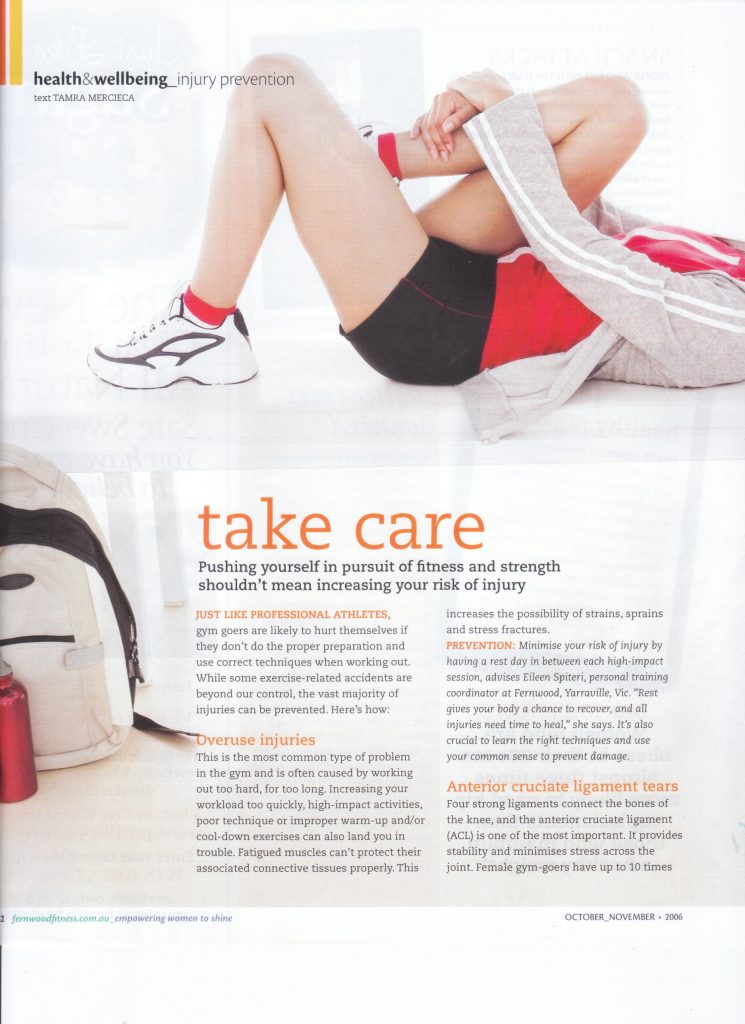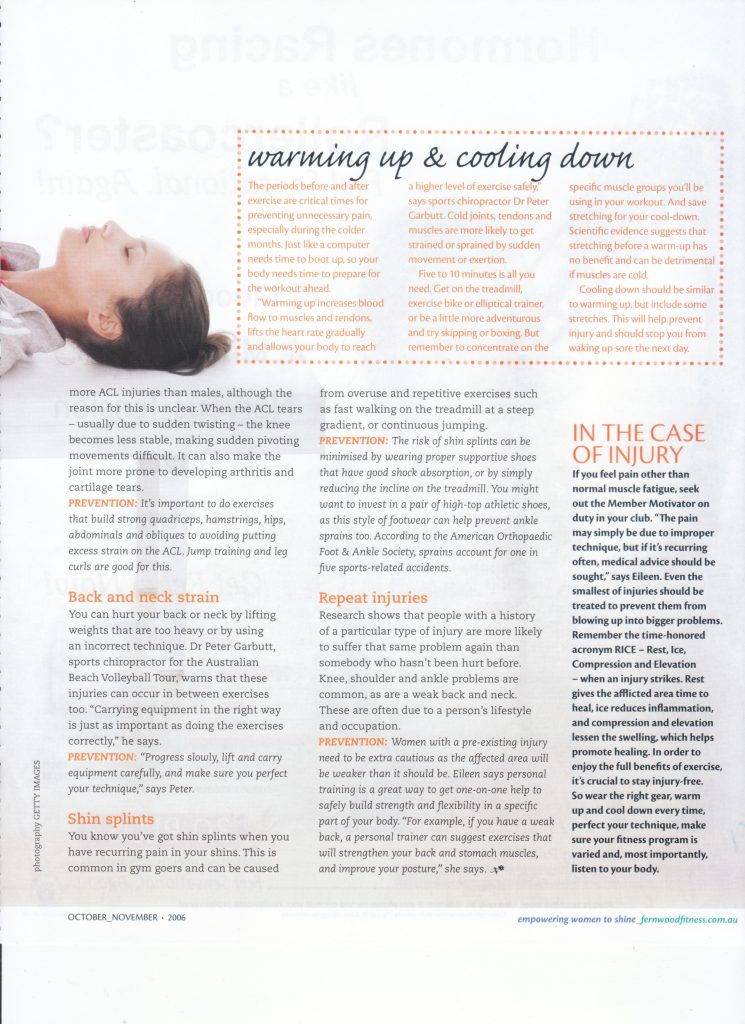

Preventing Injuries
The world of fitness has opened up to women like never before, but so too has the world of fitness injuries. Tamra Mercieca takes a look at some of the more common injuries women suffer in the gym and how to prevent them.
In ancient Greece, where the Olympics originated, not only were females forbidden from participating in the games, they weren’t even allowed to watch. Women who violated these rules literally paid a high price: they were thrown from a cliff to their death.
Fast-forward to the present day, and the number of female gym-goers has risen dramatically. But the swelling ranks of physically active women has led to the literal swelling of ankles, knees, elbows and assorted other body parts subjected to the rigors of exercise.
Gym-goers, just like professional athletes, are just as prone to hurting themselves if they don’t do the proper preparation. While some accidents are beyond our control, the vast majority of fitness injuries can be prevented.
overuse injuries
The most common type of injury female gym-goers are likely to sustain is an overuse injury, often caused by working out too much for too long. Increasing your workload too quickly, high impact activities, poor technique or improper warm up / cool down exercises can also lead to overuse injuries. Fatigued muscles do a poor job of protecting their associated connective tissues, increasing the risk of strains, sprains and stress fractures.
prevention: The Personal Training Coordinator at Fernwood Yarraville, Eileen Spiteri, says the risk of suffering an overuse injury can be minimised by having a rest day in between each high impact session. “Rest gives the body time to recover, as all injuries need time to heal.”
Sonia Mills is a professional rower who is currently representing Australia at the world championships in Europe. She says repetitive strain or overuse injury related problems are common among the female row team. “That is why is it crucial to learn the right technique and be serious about self-management to prevent injury.”
anterior cruciate ligament (ACL) injuries
Female gym-goers have up to ten times more ACL injuries than males, although the reason for this is not clear. When an ACL injury occurs the knee becomes less stable, making sudden pivoting movements difficult. It can also make the knee more prone to developing arthritis and cartilage tears.
prevention: It is important to do exercises that build strong quadriceps, hamstrings, hips, abdominals and obliques. Jump training and leg curls are good for this.
back and neck strains
Back and neck strains are also common in the gym setting and can occur in a couple of ways. Peter Garbutt, the sports chiropractor for the Australian Beach Vollyball tour, says carrying weights or equipment incorrectly can do damage. “Carrying equipment with the correct technique is just as important as doing the exercises correctly.” You can also hurt your back or neck by lifting weights that are too heavy.
prevention: Garbutt says the take home message on this one is: “Progress slowly, lift and carry equipment carefully, and make sure you keep strict technique.”
shin splints
You know you are suffering from shin splints when you are experiencing reoccurring pain in the shins. This is a common occurrence in the gym and again, this can be caused from overuse and repetitive exercises such as fast walking on the treadmill at a steep gradient, or continuous jumping.
prevention: The incidence of this can be minimised by wearing proper supportive shoes that have good shock absorption, or simply reducing the incline on the treadmill. You might want to invest in a pair of high-top athletic shoes, as this style of footwear can help prevent ankle sprains, an injury, according to the American Orthopedic Foot and Ankle Society, accounts for one in five sports-related injuries.
pre-existing injuries
Often women who join a gym have pre-existing injuries. Knee, shoulder, and ankle injuries are common along with a weak back and neck. Often these are due to lifestyle and occupation. Research shows that people with a history of a particular injury are more likely to suffer that same injury again, than somebody who hasn’t been injured before.
prevention: Women with a pre-existing injury need to be extra cautious, as that area will be weaker than it could be. Spiteri says personal training is a great way to get one-on-one help to progressively and safely build up the strength and flexibility in that area. “Exercise in the gym can improve posture through strengthening the back and stomach muscles.”
warming up / cooling down
The periods before and after exercise are critical times for preventing unnecessary pain, especially during the colder months. Just like a computer needs time to boot up, so does our body need time to prepare for the work load ahead.
Garbutt says, “warming up increases blood flow to muscles and tendons, lifts the heart rate gradually and allows your body to reach a higher level of exercise safely”. Cold joints, tendons and muscles are more likely to get strained or sprained by sudden movement or exertion if they are not warm.
how? A five to ten minute warm-up is all you need. Get on the treadmill, exercise bike or elliptical trainer, or be a little more adventurous and try skipping or boxing. But remember to concentrate on the specific muscle groups you will be using in your workout.
Cooling down should be much the same as warming up but should also include stretches. This will not only help in injury prevention but will also stop you from pulling up sore the next day.
Just a word of warning: Scientific evidence suggests that stretching before a warm-up has no benefit and can be detrimental if the muscles are cold. Therefore stretching is best done after your workout.
in the case of injury
If someone feels pain other than normal muscle fatigue, they should seek out the Member Motivator on duty. Spiteri says, “the pain may simply be due to improper technique, but if the pain is reoccurring medical advice should be sought.
Even the smallest of injuries should be treated to prevent them from blowing up into bigger problems. Remember the time-honored acronym RICE – rest, ice, compression and elevation – when an injury strikes. Rest gives the afflicted area time to heal, ice reduces inflammation and swelling, and compression and elevation lessen swelling, promoting healing.
In order to enjoy the full benefits of exercise, it’s crucial to stay injury free. So wear the right gear, warm up and cool down, use proper technique, have variety in your program, and most importantly, listen to your body!
